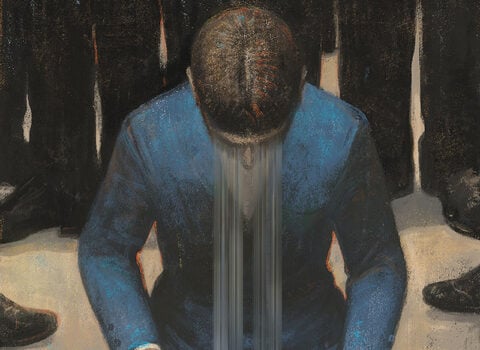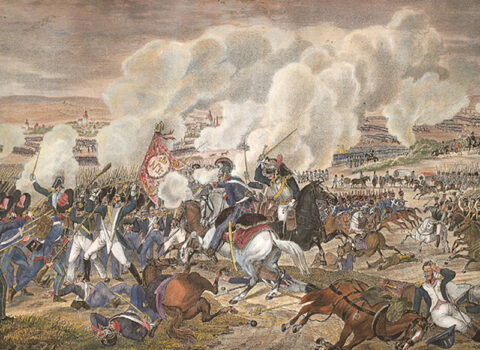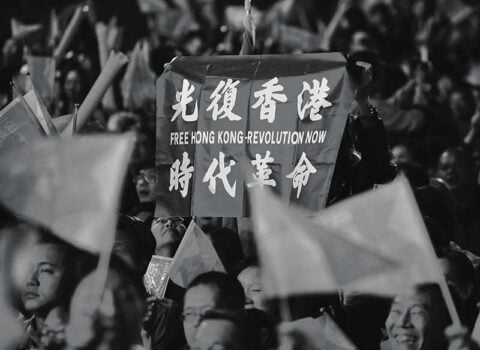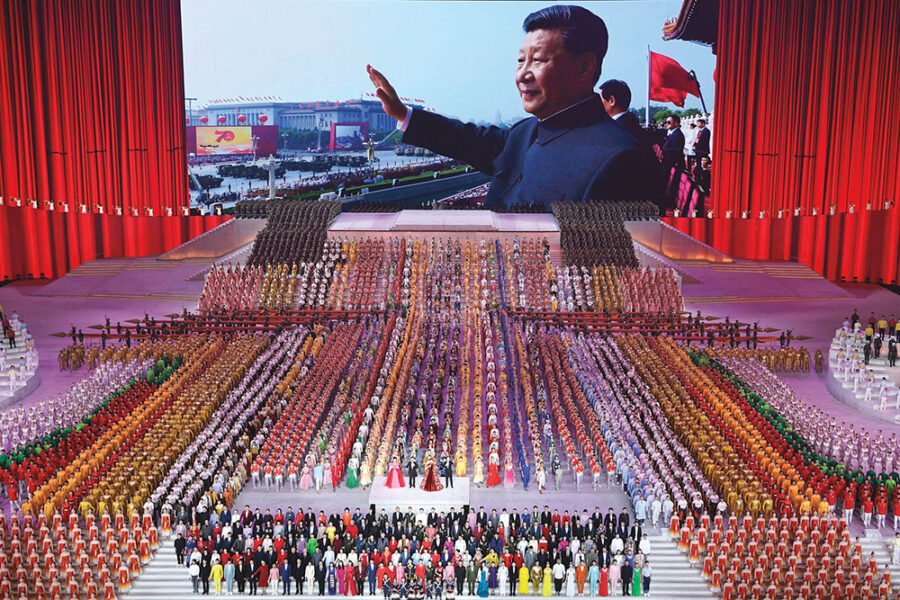
A celebration of the hundredth anniversary of the Chinese Communist Party at the National Stadium in Beijing, June 28, 2021 © Kyodo/Reuters Connect
When Xi Jinping spoke last July at a ceremony in Tiananmen Square to celebrate the centenary of the Chinese Communist Party, he did not sound particularly festive. Although dressed in a gray Mao suit—a style barely seen in China these days—he didn’t sound like Mao either, even though the late chairman and socialism (“with Chinese characteristics”) were lavishly praised. The speech was defiantly nationalistic.
China, Xi said, had been humiliated by foreign powers since the nineteenth-century Opium Wars. As a result, “people were subjected to great pain, and the Chinese civilization was plunged into darkness.” But the Communist Party had liberated the Chinese people. Taiwan, he promised, would soon be reunified with mainland China. Indeed, the CCP would “unite all the sons and daughters of the Chinese nation, both at home and abroad, behind the goal of national rejuvenation.”
The Chinese people, Xi continued, would not “accept sanctimonious preaching from those who feel they have the right to lecture us.” Foreigners who might think of trying to “bully, oppress, or subjugate us . . . will find themselves on a collision course with a great wall of steel forged by more than 1.4 billion Chinese people.”
Chinese sensitivity about foreign meddling is partly the result of historical trauma. Not only did the Opium Wars waged by the British in the mid-1800s open China up to aggressive encroachments such as extraterritorial rights in Shanghai and other cities exempting foreigners from local law, but the brutal Japanese invasions of the 1930s caused the violent deaths of millions of Chinese. There is, however, more at stake in Xi’s repeated calls for “rejuvenation” and “unity,” something that speaks to the fundamental question of what it is to be Chinese.
China is a civilization as well as a state, so Chinese identity comes in several overlapping forms: ethnic, cultural, political. People in Taiwan today don’t feel that they are part of the People’s Republic of China, and don’t want to be. Yet the descendants of Chinese immigrants there rightly see themselves as better custodians of traditional Chinese culture than their brethren on the mainland. Many people in Hong Kong prefer to call themselves Hong Kongers rather than Chinese. Most Tibetans and Uighurs don’t think of themselves as Chinese at all. But people who have lived for generations in Singapore, Malaysia, or San Francisco’s Chinatown do.
Ethnically, the majority of people in China (roughly 90 percent), as well as in the diaspora in Southeast Asia and the West, think of themselves as Han Chinese. But this is a rather arbitrary label. Southern Chinese dialects are incomprehensible to northerners, for example. In addition, the Chinese nation now officially includes peoples, such as the Turkic Uighurs and the Mongolians, who would have been called barbarians in the past. The Qing dynasty (1644–1912) annexed first Taiwan, inhabited by many non-Han people, and then Tibet and Xinjiang (which means “new frontier”). The Qing emperors themselves were not Han either, but Manchu, a people from the other side of the Great Wall who had traditionally been regarded as uncivilized nomads.
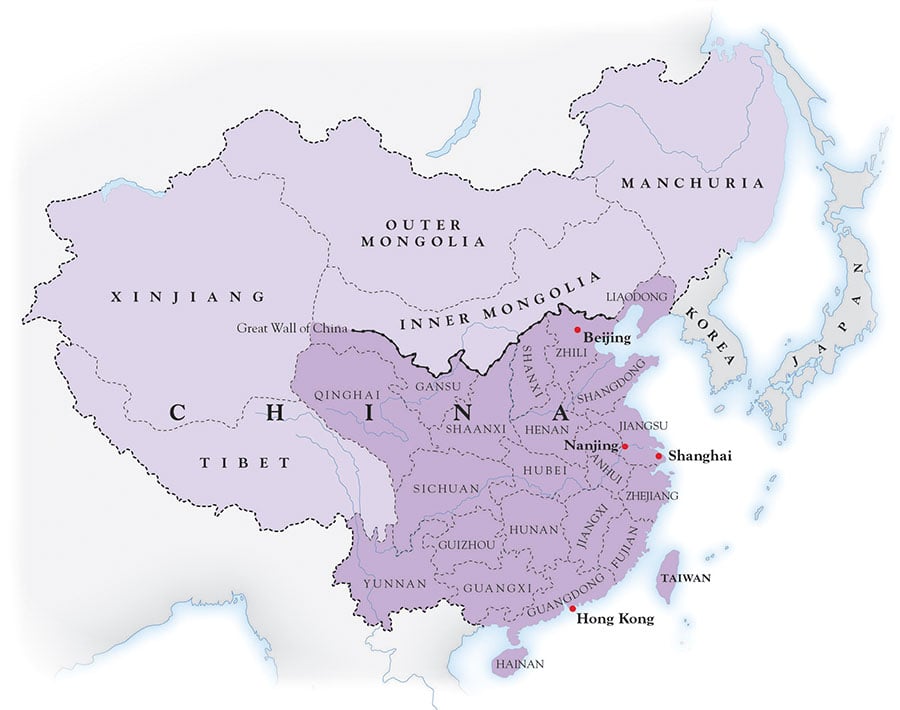
Maximum extent of the Qing Empire (1644–1912). Map by Mike Hall
On the surface, Xi’s brand of Chinese nationalism is not rooted in ethnicity, but is rather an attempt to claim that the Communist Party is the only legitimate ruler of all those living within the borders of the former Qing Empire. That is why rival nationalisms in Taiwan and Hong Kong cannot be tolerated. And yet, there is a strong undercurrent of ethnic feeling. For more than two thousand years, Chinese rulers have exacted obedience and claimed legitimacy on the basis of some kind of orthodoxy, whether it be Confucianism, or Marxism-Leninism and Mao Zedong Thought. In the Eighties, as the reforms introduced by Deng Xiaoping weakened the grip of the Maoist version of Communism, a defensive, embittered nationalism became the party’s justification for continued rule. If Maoist ideology no longer has much credibility, the old appeal to Chinese patriotism does. In this narrative, the CCP restored the pride of the Han Chinese. Xi has taken up this theme and made it something even more emotive: a promise of greatness to make up for a history of humiliation and submission to outside predators. At a meeting of senior party members in November, Xi Jinping Thought was officially endorsed not only as “Marxism for the 21st century” but as “the essence of the Chinese culture and China’s spirit.”
Ethnic nationalism is often associated with nation building in nineteenth-century Europe. In China, it is considerably older. After the Han Chinese Ming dynasty was defeated by the Manchu founders of the Qing dynasty in the seventeenth century, rebels who hoped to restore the Ming saw the new regime as foreign usurpers who would destroy Chinese civilization. Certain Manchu customs were indeed imposed on the Han. Men were forced to wear their hair in a queue, for example, which they deeply resented. But the Manchu elite gradually absorbed Han culture. Qing emperors polished their skills in Chinese calligraphy, wrote classical Chinese poetry, and collected Chinese fine art.
Still, anti-Manchu sentiment among the Han persisted. One of the most violent revolts erupted in 1850. In his speech, Xi called it an attempt by “noble-minded patriots” to “pull the nation together.” This is an odd way to describe the Taiping Rebellion. The “patriots” were led by a failed scholar named Hong Xiuquan, who believed he was the brother of Jesus Christ. Hong was a Hakka, a minority within the Han. His aim was to bring down the corrupt Manchus. But first the Han had to be converted to his idea of a pseudo-Christian Heavenly Kingdom on Earth—the Taiping—ruled by Hong himself.
Hong’s followers massacred large numbers of Manchus. They occupied cities throughout China and turned them into dictatorial fiefdoms of the Taiping cult. Millions of people fled their homes. Some of the Taiping’s actions resembled those of Mao’s Cultural Revolution a hundred years later; countless Buddhist, Taoist, and Confucian temples and shrines were destroyed. By the time the Qing armies finally crushed Hong’s Heavenly Kingdom in 1864, at least twenty million people had died—making it one of the bloodiest conflicts in history.
Also mentioned approvingly in Xi’s July speech was the revolution that brought down the Qing dynasty. The father of the republic that replaced it was Sun Yat-sen, a Christian who had spent many years exiled in the United States, Europe, and Japan. The three principles of his revolution were “democracy, nationalism, and popular welfare.” But his idea of nationalism had a strong ethnic slant. A newspaper run by his acolytes put it more bluntly: “To restore our independence, we must first restore the Chinese nation. To restore the Chinese nation, we must first drive the barbarian Manchus back to the Changbai mountains.”
Xi’s fiery words about the great unity of the Chinese people thus followed a long line of precedents. Rebels and revolutionaries in China have almost invariably promised to reunite or rejuvenate the nation under some grand scheme of moral restoration, be it Confucian, pseudo-Christian, or Communist. This kind of nationalism is often a mixture of utopianism and anti-foreign sentiment, elements shared by the movement that birthed the Chinese Communist Party. But, Xi stressed, the Communists had succeeded where earlier efforts had failed.
The May Fourth Movement of 1919 began as a student protest. In the Versailles Treaty, after World War I, parts of China administered by Germany were handed over to Japan. This was seen as a betrayal on the part of the Allied Powers. Outraged students across China called for a boycott of Japanese goods.
Yet the movement was about much more. Idealistic students believed that traditional Chinese culture, and Confucianism in particular, was stifling modernization. China could develop and rejuvenate only if the old ways were discarded and replaced by new ideas. Students celebrated “Mr. Democracy” and “Mr. Science” even as they shouted slogans denouncing Japan, as well as the Chinese government for its failure to stand up to foreigners.
The irony was that Japan was the source of many of the ideas that Chinese students and intellectuals were fighting for. Many Chinese had studied in Japan. Concepts such as democracy, psychology, and liberalism entered the Chinese language via Japanese translations of Western terms. Even the word “nationalism” (minzuzhuyi) in Sun Yat-sen’s three principles came from the Japanese minzokushugi. The usual translation is “ethnonationalism.” Minzu is a tribal term, denoting something closer to a race than a nation.
This rhetoric doesn’t mean that all supporters of the May Fourth Movement were racists, or even Han chauvinists. They ranged from liberal admirers of the American social reformer John Dewey to Communists inspired by the Russian Revolution. Mao Zedong praised May Fourth as a “new stage in China’s bourgeois-democratic revolution against imperialism and feudalism.” These are the wooden words of Communist jargon. But in the sense that the protesters aimed to undo the indignities of foreign aggression, Mao was right. At best, May Fourth inspired an enlightened nationalism. At worst, it led to a new kind of dictatorship under Communist rule.
In theory at least, Mao was critical of Han chauvinism. He believed that nationalist ideologies were remnants of feudalism and reactionary bourgeois thinking. Communist doctrine, after all, promised that the workers of the world would one day unite. He was also steeped in Chinese history. Strangely for an avowed anti-imperialist, he accepted the Qing dynasty’s expansion, and looked to the third-century bc emperor Qin Shi Huang as a model. The Qin emperor is best known as a despot who supposedly buried Confucian scholars alive and burned their books, but it was he who first brought large parts of today’s China under one rule. Mao saw himself as a great unifier in the same mold, but like the Qing Empire, Mao’s China would include a patchwork of ethnic groups. When Japan invaded China in the Thirties, Mao argued for enlisting Tibetans, Mongolians, and other minorities in the struggle against Japan. “They shall have the right to handle their own affairs,” he said, “and at the same time to unite with the Hans in building a unified country.”
Fine words. But they pointed to a contradiction that neither Mao nor the Communist leaders who succeeded him were able to solve. If minorities were allowed to handle their own affairs, speak their own languages, and preserve their own cultures, then how could they be mobilized into unifying the nation? The party’s solution was to indoctrinate and incorporate non-Han peoples into the dictatorship of the proletariat. They could speak their own languages and keep their cultures (in diminished form) as a kind of folklore, but they also had to conform to Communist orthodoxy. In practice, this led to the destruction of their traditions; Tibetan Red Guards took an active part in razing Buddhist temples in Tibet. When minority peoples resisted the annihilation of their cultures in the name of Marxism-Leninism and Mao Zedong Thought, they were accused of “local nationalism,” which is pretty much the same thing democracy activists in Hong Kong and people in Taiwan are accused of today.
The worst humiliation inflicted on China, commemorated in monuments, museums, movies, TV dramas, and textbooks, was the decade of war with Japan that ended in 1945. That China had been defeated by a superior Japanese military force in 1895, in a short conflict over the control of the Korean peninsula, was bad enough. But the devastation wreaked on China by the imperial Japanese armed forces in the Thirties was of another order. The Nanjing Massacre in 1937, when as many as several hundred thousand people were murdered by Japanese troops, was only the worst of many atrocities. It is remembered in China today as a war crime on par with the Nazi death camps.
But anti-Japanese grievance goes further than memories of war. For most of its long history, China had regarded the Japanese as a barely civilized, peripheral people. They were called “dwarf pirates” because of their frequent raids off the Chinese coast. Like Koreans or Vietnamese, Japanese delegations were expected to visit Chinese imperial capitals to kowtow to the emperor. The rapid modernization of Japan in the late nineteenth century reversed these roles. China was now the weaker nation, and Chinese began to visit Tokyo to imbibe the scientific, political, intellectual, and military knowledge needed for their own modernization.
Japanese attitudes toward China also changed radically. Instead of looking at the Middle Kingdom as the source of culture and knowledge, the Japanese transferred their attention to Europe and the United States. China was regarded as a decadent wreck of past glory. It was now Japan’s turn to lead the way. When Xi spoke about Chinese resentment at being lectured by foreigners, he may have been thinking not only of contemporary criticism of human-rights abuses in Xinjiang, but also of Japan’s depredations since the late nineteenth century.
And yet, Japanese empire building in China offers a clear model for contemporary Chinese nationalism. This is particularly true of the brutal Japanese experiment in the Thirties in Manchuria, the region that now comprises the northeastern provinces of China and the original homeland of the Manchu people. Ever since the Sino-Japanese War in 1895, Japan had wanted to take control of Manchuria as a source of raw materials, a space for Japanese emigration, and a buffer against Russia. The government in Tokyo had tried to do so by diplomatic means, but a group of ultranationalistic middle-ranking Imperial Army officers decided to force the issue.
On September 18, 1931, Japanese soldiers faked a bomb attack on a railway line in Mukden (now Shenyang) and blamed it on Chinese terrorists. Japanese troops quickly deposed the local Chinese warlord and seized the major cities in Manchuria. In 1932, the Japanese founded the state of Manchukuo, with the hapless last Qing emperor, “Henry” Puyi, on the throne. Manchukuo’s independence was a sham. Behind every Chinese or Manchu official stood a Japanese “adviser” who told him exactly what to do.
Japanese propaganda presented the state as a multiethnic, anti-imperialist, thoroughly modern utopia. Manchus, Chinese, Japanese, Koreans, and Mongolians, represented by the different colors of the Manchukuo flag, would be treated equally. The Concordia Association, the state’s only permitted political party, was founded to promote racial harmony.
Hostility to liberal Western models of democracy was a constant theme in official Manchukuo rhetoric. As is the case with today’s Chinese nationalism, this was born of resentment and feelings of exclusion: Japan’s 1919 demand for racial equality in the League of Nations had been denied by Australia and the United States. Manchukuo would offer an alternative, Asian model of modernity: fast trains, big buildings, and state-controlled industrial development on a massive scale. Japan would champion “Asian values,” to use a more modern term, but these values were, of course, not Manchu, Chinese, or Korean, but Japanese.
Similar attitudes can be seen today in the People’s Republic of China. It, too, promotes an Asian model of progress held as superior to the tired and decadent Western democracies, hence the contrast drawn in Chinese media between China’s efficiency in tackling COVID-19 and the blundering efforts in the West. The insistence that firm authoritarian rule is more effective—and more traditionally Asian—than messy democratic procedures is something contemporary China has learned from Manchukuo. New infrastructure, such as the high-speed train line that traverses the Tibetan Plateau, and other symbols of modernity are used to justify Han Chinese rule in minority areas.
But mixed in with the anti-Western posturing in Manchukuo was an anxious desire to impress the West. This, too, is conspicuous in Xi’s centenary speech. The phrase “show the world” recurs in many places, as in:
Through tenacious struggle, the Party and the Chinese people showed the world that the Chinese people had stood up, and that the time in which the Chinese nation could be bullied and abused by others was gone forever.
The utopian fantasy of Manchukuo attracted many Japanese nationalists, militarists, and shady adventurers, but also left-wing economic planners, architects, engineers, filmmakers, and businessmen. Like Mao’s China, Manchukuo was viewed as a blank slate. Some of its promises were realized—the fast trains, the big buildings, the modern urban centers, the industrial enterprises. But the vision of social harmony promised by Manchukuo was irredeemably fraudulent. The anti-imperialist nation was itself an imperial project. Different races were not considered equal at all. Japan treated different ethnic groups nearly as harshly as the CCP treats Tibetans and Uighurs today. They had to conform to Japanese militarist ideology, worship the Japanese emperor, and adapt to Japanese culture.
Manchukuo collapsed as soon as Japan was defeated in 1945. The Japanese chief of propaganda wore his Concordia Association uniform when he took cyanide on the day of the defeat. But the Japanese experiment left a strong mark. So-called Concordia speak—admired for its militant tone, even though the Chinese had been Japan’s victims—entered the Chinese idiom. When Mao tried to rally minority peoples behind a common front by promising them autonomy, he was echoing Concordia speak. When Red Guards were told to destroy all vestiges of the past, including great architectural treasures, Manchukuo was left untouched. The grandiose Japanese buildings in Changchun, the former capital, that once housed the Japanese police are now occupied by the CCP’s Public Security Bureau.
Hatred of Japan, and resentment over the horrors suffered during Japanese occupation, now form a kind of bedrock of Chinese nationalism. It doesn’t take much to incite mobs to attack Japanese stores or boycott Japanese products—even as millions of Chinese eagerly visit Japan as tourists. The Chinese government has a habit of turning such popular sentiments on and off like a tap. The danger is that they can get out of control and be redirected at the Chinese government itself, as in 1919.
Anti-Japanese demonstrations in the People’s Republic, however, began in earnest only after Mao died in 1976. Chinese had bitter memories of the Japanese war, but Mao had no interest in casting China as a martyr. On the contrary: he stressed the heroism of the Chinese people who had risen against their feudal oppressors, and rejuvenated China as a shining avatar of the proletarian revolution. The main enemies of the people were not foreigners so much as the “landlord class,” “capitalist roaders,” “revisionists,” and other antirevolutionary elements in China itself.
Symbols of Chinese suffering, such as the Nanjing Massacre of 1937, were ignored, not least because the Communists were nowhere near Nanjing when it happened. Nanjing was the capital of Chiang Kai-shek’s Nationalists, who bore the brunt of Japan’s military force. Movies about what is officially known as the Chinese People’s War of Resistance Against Japanese Aggression were already being made in the Fifties and Sixties. But they invariably featured heroic Communist guerrilla fighters, not humiliated Chinese victims.
When the Japanese prime minister, Tanaka Kakuei, visited China in 1972, hoping to restore official relations between the two former adversaries, he had an extraordinary conversation with Mao. Tanaka, who had served as a soldier in Manchukuo, apologized to Mao for the Japanese invasion of China. Mao, according to his personal physician Li Zhisui, dismissed the apology. Without the Japanese invasion, Mao said, the Communists would not have been able to defeat Chiang Kai-shek and rise to power. Perhaps he was being ironic. But he was probably right.
Mao was in no hurry to reclaim Hong Kong. And China’s participation in the Korean War, as well as the need to consolidate Communist rule on the mainland, prevented him from paying much attention to Taiwan. Class struggle, permanent revolution, and the cult of Chairman Mao replaced outward signs of nationalism and Han chauvinism, which Mao continued to dismiss as bourgeois thinking. What was left of Chinese nationalism was temporarily deflected into pride in leading global, or at least Third World, revolution.
This began to change soon after Mao’s death. Mao’s campaigns to eliminate class enemies had caused such horrendous suffering that Maoist ideology lost much of its appeal. Deng Xiaoping, who came to power in 1977, realized that the country had to be rejuvenated once again, this time by lifting it out of terrible poverty. Ideological purity was not his main concern. He said it made no difference to him whether a cat was black or white, so long as it could catch mice. Communist dogma was softened to allow capitalist reforms. China’s attempt at economic self-sufficiency was abandoned. To create wealth, the country needed to open up for business, not just with the United States, where Deng charmed his hosts in 1979 by wearing a ten-gallon cowboy hat, but with Japan as well.
This was risky, for Chinese governments are always vulnerable to accusations from nationalists that they are bending to foreign powers. Even more dangerous, Deng’s reforms jeopardized the ideological justification for the Communist Party’s monopoly on power. This is why, in the Eighties, the kind of nationalism now promoted by Xi began to replace the Maoist version of Communism. The massive Memorial Hall of the Victims of the Nanjing Massacre by Japanese Invaders was built in Nanjing in 1985 to remind people of the “300,000 victims.” That 300,000 people were murdered, and not, say, 150,000, or fewer, as some Japanese historians have claimed, is a matter of dogma that cannot be questioned.
There are other memorials in Guangdong, where the Opium Wars began, and in Shenyang, at the site of the fake bomb attack that led to the Japanese annexation of Manchuria. The point made in these museums is always the same: Chinese people, wherever they are, must remember their past suffering, and only the Communist Party can protect them from such catastrophes.
The need to stress past atrocities by foreign powers, and the party’s essential role in uniting and protecting the Chinese nation, became even more apparent after the Tiananmen Square demonstrations in 1989. The People’s Liberation Army crushed the protests with tanks, but the party had lost face. Some conservatives argued that Maoist doctrine needed to be revived. But others preferred to boost “patriotic education.” School curricula were filled with patriotic films, patriotic songs, and patriotic books. More and more memorials were built to remind people of past atrocities.
And so, this angry nationalism became the latest orthodoxy to justify the authority of China’s rulers. Lip service is still paid to Mao’s legacy—thus Xi’s Mao suit. But Xi expressed the new party dogma clearly: “The time in which the Chinese nation could be bullied and abused by others [is] gone forever.”
Meanwhile, the PRC has reverted to some of the traditional attitudes of imperial China. The old boundaries of the former Qing Empire are being expanded into the South China Sea through the construction of artificial islands that house military bases. Former tributaries of the Middle Kingdom are once again expected to pay deference to China’s rulers and conform to Chinese interests. When South Korea agreed to deploy a new U.S. anti-missile system on its soil, China boycotted Korean imports—not just cars and TV sets, but K-pop CDs and video games.
Inside China, earlier promises of cultural and political autonomy have made way for forced assimilation. Uighurs are being imprisoned in harsh camps where they are made to renounce their religion, culture, and language. Last August, the seventieth anniversary of the invasion of Tibet by the People’s Liberation Army was celebrated in front of the Potala in Lhasa, once the sacred palace of Tibetan Buddhist leaders. A senior official from Beijing told Tibetans that they had to embrace Communist Party rule and share the “cultural symbols and images of the Chinese nation.” Religion, too, had to be “Chinese in orientation.”
These are extreme versions of the traditional expectation in China that people be civilized by becoming Chinese. But it was one thing to expect Manchu aristocrats to master classical Chinese, and quite another to force millions of ordinary people to renounce their languages and customs. What has not changed is the identification of culture and civilization with a certain political dogma. Whether you live in Beijing, Tibet, Xinjiang, Hong Kong, or Taiwan, the party insists that to be Chinese is to be Communist.
When President Joe Biden says that the growing might of China is a challenge to the democratic world, he may be right. China, he believes, with some reason, is a model of authoritarianism, and we’re “kind of at a place where the rest of the world is beginning to look to China.” He has promised that on his watch China will not become “the leading country in the world, the wealthiest country in the world, and the most powerful country in the world.”
Perhaps not. But by framing the antagonism as a clash of civilizations, Biden is playing to China’s strengths. There is no such thing as a coherent democratic world. Democracies are divided on how to deal with China. Britain, Germany, and France, let alone Japan, have no desire to harm their economic interests in China by seeking confrontation. China, on the other hand, is oppressive and authoritarian, but it is also cohesive. In a conflict with the West, the People’s Republic of China will claim that it is not only fighting for Communism with Chinese characteristics, but for Chinese civilization itself. And there are at least a billion people, if not more, who might well go along with that.

